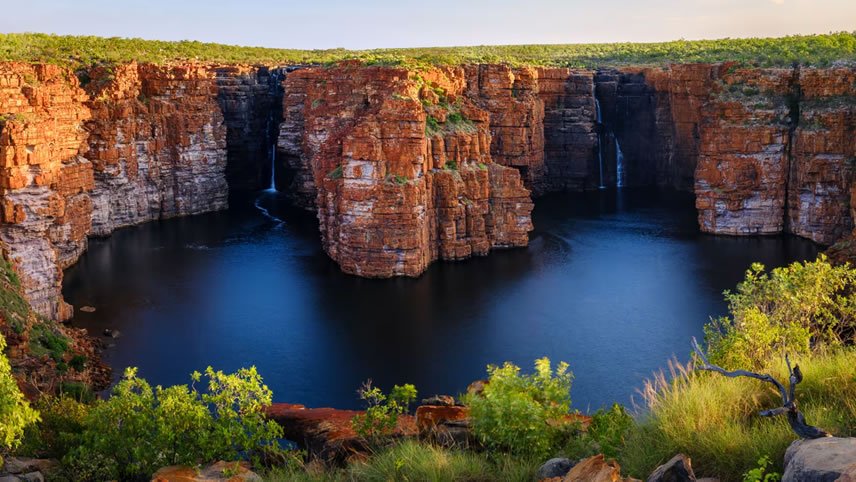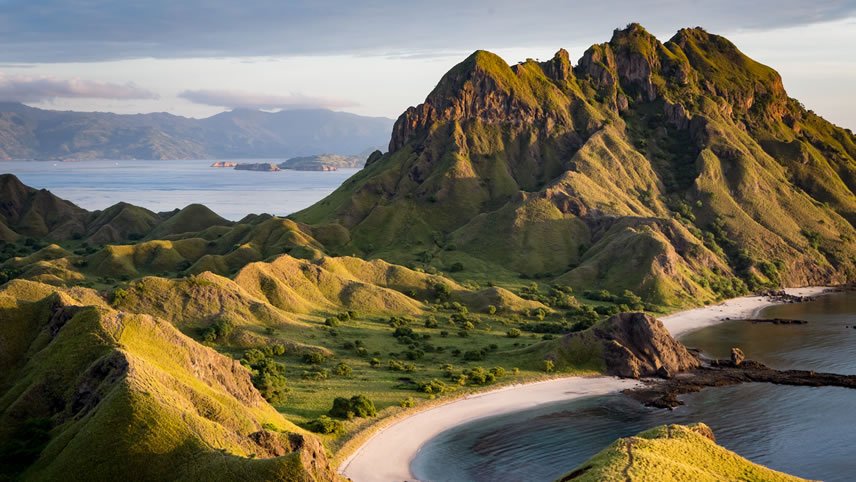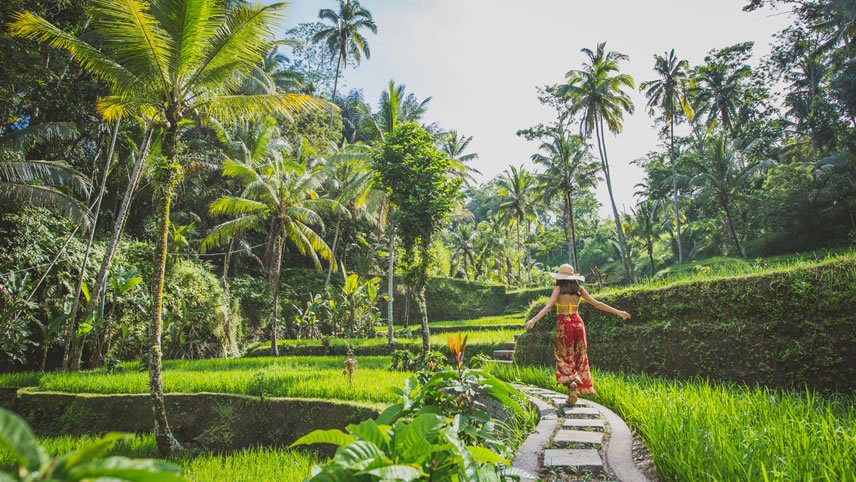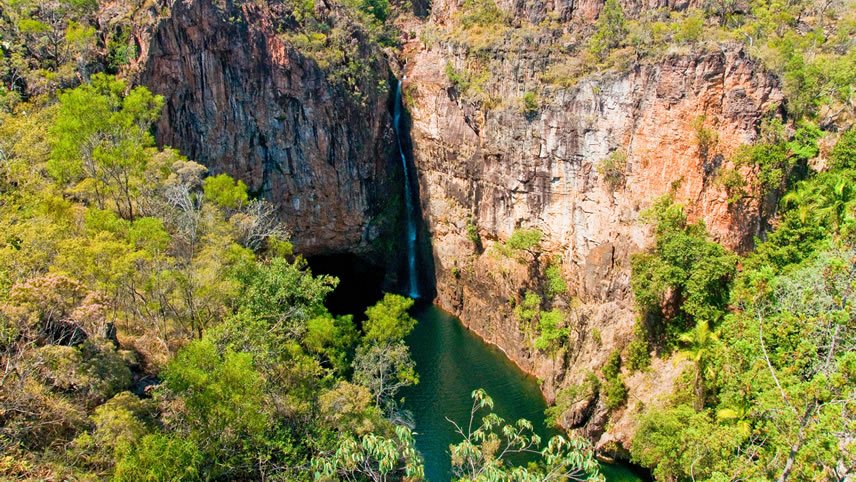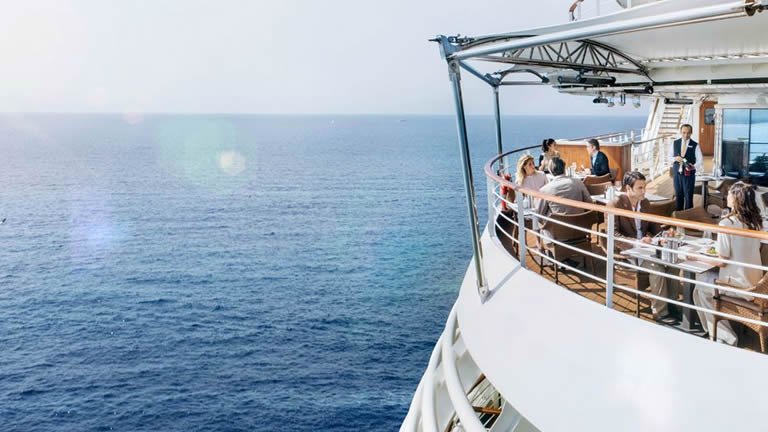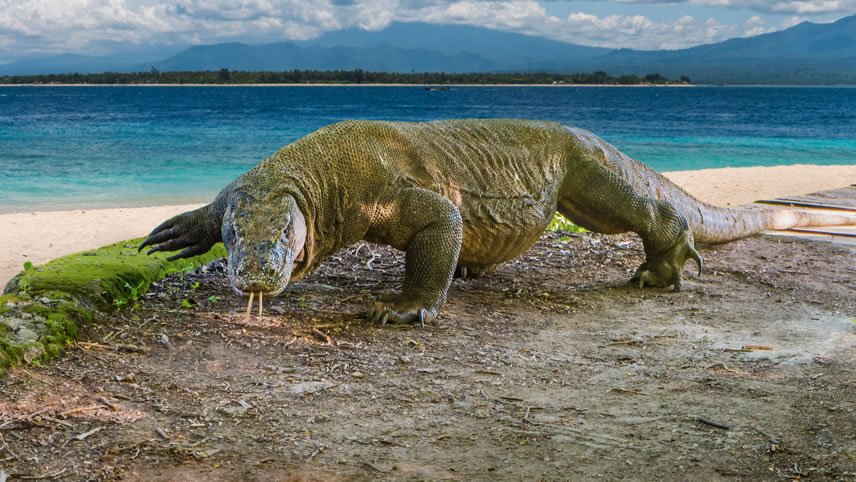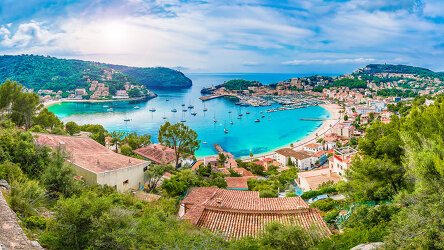Overview
Cruise Itinerary
Australia's only tropical capital city, Darwin is rich in culture and ethnically diverse. While the Northern Territory boasts some of the most incredible wildlife on the planet, the city's museums celebrate the city's past and the galleries showcase the region's rich indigenous art. Ships will dock at Fort Hill Wharf.
Top Things to Do in Darwin:
- cruise the Darwin Harbour
- explore Litchfield or Kakadu National Park
- visit the Museum and Art Gallery of the Northern Territory
- take a Jumping Crocodile Cruise
- visit the Darwin Botanic Gardens
Koolama Bay, located in the remote Kimberley region of Western Australia, is steeped in both natural beauty and historical significance. This secluded bay, named after the SS Koolama ship that was bombed during World War II and subsequently beached here, offers a poignant reminder of Australia’s wartime history amidst a landscape of dramatic coastal wilderness.
The bay is part of the larger Cambridge Gulf, known for its rich marine life and significant tidal movements, which sculpt its striking mudflats and mangroves. Accessible primarily by boat, Koolama Bay serves as a gateway to exploring the rugged Kimberley coast, with opportunities for fishing, bird watching, and soaking in the untouched natural scenery. Its isolation and pristine environment make it an intriguing destination for those exploring one of Australia’s most unspoiled regions.
Swift Bay, located in the remote Kimberley region of Western Australia, is renowned for its breathtaking natural beauty and ancient Aboriginal rock art. The bay's rugged coastline, with dramatic cliffs and secluded beaches, offers a pristine escape from the modern world. A key attraction of Swift Bay is its remarkable collection of Aboriginal rock art, depicting animals, human figures, and traditional symbols. These ancient artworks provide valuable insights into the lives of the Indigenous people who have inhabited the area for thousands of years.
Accessible primarily by boat, Swift Bay remains largely untouched, allowing visitors to experience the raw, unspoiled beauty of the Kimberley. Its combination of cultural heritage and natural splendour makes Swift Bay a unique destination in Western Australia.
Hunter River in Western Australia’s remote Kimberley region offers an extraordinary blend of rugged beauty and rich wildlife. This secluded area, accessible mainly by sea, features towering sandstone cliffs and cascading waterfalls. The river's tranquil waters are perfect for leisurely cruises, providing opportunities to spot saltwater crocodiles and an array of bird species.
Explore the ancient Indigenous rock art sites that dot the landscape, offering a glimpse into the region’s deep cultural heritage. The surrounding wilderness is home to diverse flora and fauna, making guided bushwalks a must for nature enthusiasts. Hunter River promises a captivating experience, combining breathtaking scenery with fascinating wildlife and cultural insights.
Freshwater Cove, located in the remote wilderness of the Kimberley region in Western Australia, is a hidden gem that offers stunning natural beauty and significant cultural heritage. This secluded spot is accessible primarily by sea, making it a popular destination for small ships exploring the Kimberley coast. The cove is renowned for its ancient rock art, created by the indigenous Worrorra people, which provides a fascinating glimpse into Australia’s ancient cultural history.
Visitors to Freshwater Cove can enjoy guided walks to view these remarkable rock art galleries, set against the backdrop of dramatic cliffs and lush vegetation. The area also offers excellent opportunities for birdwatching, with the untouched environment supporting a diverse range of wildlife.
Montgomery Reef, located off the Kimberley coast in Western Australia, is a remarkable natural phenomenon that covers over 300 square kilometres, making it one of the largest inshore reefs in the world. As the tide recedes, the reef dramatically emerges from the ocean, creating cascading waterfalls and revealing vast expanses of sea grass, marine life, and isolated lagoons.
This dynamic environment provides a unique opportunity for visitors to witness the reef's transformation and explore its rich biodiversity. The area is teeming with sea turtles, manta rays, and various species of sharks, offering an unparalleled marine experience. Montgomery Reef is not only a spectacular sight but also a vital habitat for wildlife, playing a crucial role in the local ecosystem.
Word count: 120
Days at sea are the perfect opportunity to relax, unwind and catch up with what you’ve been meaning to do. So whether that is going to the gym, visiting the spa, whale watching, catching up on your reading or simply topping up your tan, these blue sea days are the perfect balance to busy days spent exploring shore side.
Australia's only tropical capital city, Darwin is rich in culture and ethnically diverse. While the Northern Territory boasts some of the most incredible wildlife on the planet, the city's museums celebrate the city's past and the galleries showcase the region's rich indigenous art. Ships will dock at Fort Hill Wharf.
Top Things to Do in Darwin:
- cruise the Darwin Harbour
- explore Litchfield or Kakadu National Park
- visit the Museum and Art Gallery of the Northern Territory
- take a Jumping Crocodile Cruise
- visit the Darwin Botanic Gardens
Days at sea are the perfect opportunity to relax, unwind and catch up with what you’ve been meaning to do. So whether that is going to the gym, visiting the spa, whale watching, catching up on your reading or simply topping up your tan, these blue sea days are the perfect balance to busy days spent exploring shore side.
Kupang, the capital of West Timor in Indonesia, offers a blend of natural beauty and cultural experiences. This bustling port city features stunning coastal views and vibrant local markets. The Lasiana Beach, with its golden sands and clear waters, is perfect for a relaxing day by the sea.
History enthusiasts will appreciate visiting the Museum of Nusa Tenggara Timur, which showcases the region’s diverse cultures and traditions. The nearby Crystal Cave, with its clear underground lake, offers a unique adventure. Kupang is also known for its friendly locals and delicious seafood, making it a delightful and engaging destination for travelers exploring West Timor.
Kupang, the capital of West Timor in Indonesia, offers a blend of natural beauty and cultural experiences. This bustling port city features stunning coastal views and vibrant local markets. The Lasiana Beach, with its golden sands and clear waters, is perfect for a relaxing day by the sea.
History enthusiasts will appreciate visiting the Museum of Nusa Tenggara Timur, which showcases the region’s diverse cultures and traditions. The nearby Crystal Cave, with its clear underground lake, offers a unique adventure. Kupang is also known for its friendly locals and delicious seafood, making it a delightful and engaging destination for travelers exploring West Timor.
Alor, a remote island in Indonesia's Lesser Sunda Islands, is celebrated for its vibrant traditional culture and exceptional marine life. This lesser-known destination thrives on its intricate ikat weaving and ancient moko drum traditions, providing a deep cultural experience unlike any other.
The surrounding waters are a diver's paradise, known for their strong currents and teeming with a diverse array of marine species, including thresher sharks and manta rays. Ships visiting Alor typically anchor near Kalabahi, the island’s only town. From here, passengers can easily explore local villages, dive sites, and markets.
Kalabahi, the sole town on Alor in Indonesia, serves as the gateway to exploring the island's rich traditions and stunning natural landscapes. Known for its vibrant local culture, Kalabahi is surrounded by villages such as Takpala where traditional customs like ikat weaving and ceremonial dances are part of daily life. Kalabahi itself is bustling with markets that offer a variety of local crafts and fresh produce.
Alor, a remote island in Indonesia's Lesser Sunda Islands, is celebrated for its vibrant traditional culture and exceptional marine life. This lesser-known destination thrives on its intricate ikat weaving and ancient moko drum traditions, providing a deep cultural experience unlike any other.
The surrounding waters are a diver's paradise, known for their strong currents and teeming with a diverse array of marine species, including thresher sharks and manta rays. Ships visiting Alor typically anchor near Kalabahi, the island’s only town. From here, passengers can easily explore local villages, dive sites, and markets.
Close your eyes and breathe in deep - you can almost hear the gentle lapping of the waves on Hoga Island, a spectacular vision of untouched white sand beaches and reclining coconut groves. The trappings of modern life are instantly lost on this remote island, where roads and WiFi routers are replaced by stilted bungalows, jungle tracks, and glistening waves.
Drift through brilliant blue waters, streaked with ribbons of turquoise, on a canoe, spotting fish flitting past just below the crystal-clear surface. Located southeast of Sulawesi Island, Hoga Island is a gateway to some extraordinary underwater delights. Enter the waters with your snorkel gear strapped on, and you’ll be astounded by the sheer diversity of the UNESCO World Heritage Site, Wakatobi National Park. Look into a world-class underwater universe, viewing habitats teeming with fantastical coral creatures.
Clean, clear waters provide a window of startling sharpness as you swim and snorkel above the colourful reefs that conceal elegant seahorses, graceful hawksbill turtles, and stonefish. Back on land, look out for scuttling coconut crabs and enjoy relaxing beach strolls.
Buton Island seems to be small compared to its neighbour Sulawesi, but with slightly more than 4,400 square kilometers (just under 1,700 square miles) it is Indonesia’s 19th largest island. Much of the lowland consists of uplifted karst and other limestone formations. Due to its hilly topography it still has a considerable amount of forest; most of it is seasonal tropical lowland forest with mangroves in coastal areas.
Visitors to Bau-Bau, the main city on Buton Island, may well be welcomed with a mangaru, which is a welcome dance performed by three men to respect guests and to ward off enemies. Overlooking Bau-Bau is Benteng Keraton Buton, known as having been the seat of the sultan. Claiming to be the biggest fort in Indonesia and made of coral blocks, it commands an excellent view over the city and port and the sea beyond.
Palopo is a municipality in the South Sulawesi Province of Indonesia, with a population of approximately 150,000. The city has an ancient history dating back to its founding in the early 1600s. The port has always had a trade link to the highlands of Sulawesi known as Tana Toraja, and a physical link through a twisting mountain pass making it a perfect gateway to Toraja.
The land of Toraja is an ancient and mysterious place where residents adorn their homes with the horns of water buffalo killed in funeral ceremonies and ornate carvings painted in bold reds and black. In many ways the Tana Toraja customs of honoring the dead dictate their ways of life. Human remains rest in stone chambers in the hillsides and burial caves high in the cliffs. Elaborate funeral ceremonies which can take months or even years to prepare can go on for days and can draw hundreds of people in a festival-like atmosphere.
Days at sea are the perfect opportunity to relax, unwind and catch up with what you’ve been meaning to do. So whether that is going to the gym, visiting the spa, whale watching, catching up on your reading or simply topping up your tan, these blue sea days are the perfect balance to busy days spent exploring shore side.
Indonesia’s isolated Komodo Island is a natural wonder of tropical savanna and scrubland, home to the famed pre-historic Komodo dragon. Komodo National Park is the only place on earth that they can be found in the wild.
The national park is a UNESCO World Heritage Site and visitors must be escorted by a park ranger, independent exploration of the park is not permitted.
If you're leery of these reptiles, the ecologically diverse waters around the island provide superb diving and snorkelling and are home to graceful manta rays, dolphins and even seahorses.
Just when you think you’ve seen it all, a heavenly halo of an island like Pulau Satonda comes along. Appearing like a mirage from the intense turquoise waters of the Flores Sea, Pulau Satonda is an impossibly aesthetic ring of jungle-clad slopes, embracing a volcanic crater of tranquil water. Snorkel the reefs that encircle the island, or strap your boots on to hike up to the ridge. Trek with monkeys scuttling above and trees sagging under the weight of sleeping bats for the best, elevated views of the still interior lake.
Formed by the machinations of underwater volcanic activity, the island's central crater dips to a depth of 86 metres. Shrouded in local legend and tradition, Pulau Satonda has many tales to share. It was a close witness to the unimaginable ferocity of Mount Tambora’s wrath, and that ominously beautiful volcano cone is visible from the sandy beaches to the south of the island.
Mount Tambora’s fury devastated the entire planet, with the largest eruption in recorded history. The catastrophic explosion caused the Year Without a Summer in 1816, darkening and subduing skies around the world with ash. It’s theorised that a tsunami triggered by the eruption washed a wave of salt water to Pulau Satonda’s previously fresh-water lake. Dip into the refreshing waters, or make an offering on the shore by hanging a stone on a branch. If your wish comes true, you are obligated to travel back to give thanks - but a return trip to a place as beautiful as this is certainly no burden.
Bali is an island paradise renowned for its stunning beaches, vibrant culture, and lush landscapes. Start your day with a visit to the sacred Uluwatu Temple, perched on a cliff overlooking the Indian Ocean, offering breathtaking sunset views and traditional Kecak dance performances. For nature enthusiasts, the Tegallalang Rice Terraces in Ubud provide a picturesque backdrop perfect for a leisurely walk or a photo opportunity.
Don't miss the bustling markets of Ubud, where you can find unique handicrafts and local delicacies. Bali is also home to world-class spa experiences, making it an ideal place to relax and rejuvenate. Whether you're exploring the art scene in Ubud or simply lounging on the beach, Bali offers a perfect blend of adventure and relaxation.
Benoa is located on the southern tip of Bali and is the key gateway for travellers exploring this Indonesian island. The port is approximately 12 kms (7.5 miles) from the bustling city of Denpasar - a journey of around 30 minutes. You'll dock directly at the terminal, allowing easy access to transport options.
Life Onboard Silver Cloud
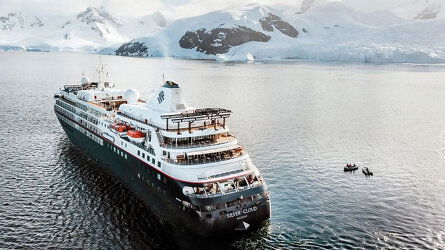
Explore remote corners of the world on an expedition cruise in ultra all suite luxury. Read more
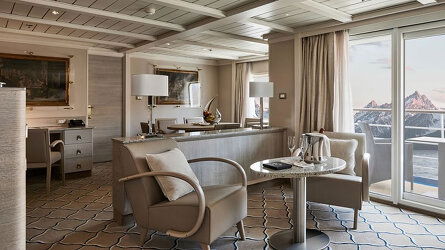
Enjoy all suite accommodation with luxury amenities and impeccable service provided by your own butler. Read more

Even an iPhone user can join expert classes and create professional images in the photo studio. Read more

Even on expedition cruises you will enjoy best in class service from the Silversea crew. Read more

Savour Silversea's exquisite fine dining and impeccable service offered in four signature restaurants on Silver Cloud. Read more
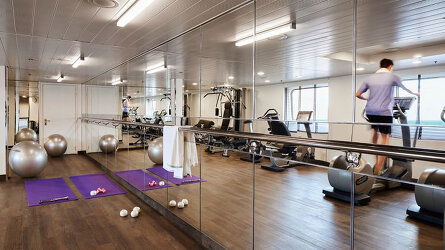
The Fitness Centre has state-of-the-art equipment and offers a range of classes. Read more
Brochure

Silversea Voyages (2025-26)
Availability
 USD
Port charges, taxes and fees included.
USD
Port charges, taxes and fees included.
Tour & cruises prices are per person. Prices shown have savings applied, are subject to availability and may be withdrawn at any time without notice. Pricing and trip details are correct at this point in time, however are subject to confirmation at the time of booking and are subject to change by Silversea. For cruise itineraries, cabin images are sourced from Silversea. These should be treated as indicative only. Cabin inclusions, upholsteries and room layout may differ to the image(s) shown depending on the ship selected and your sailing dates.
